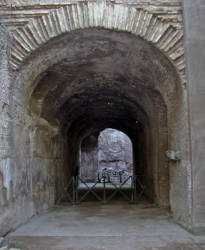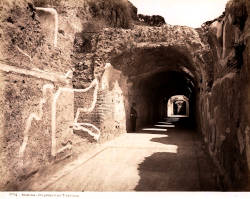Neronian Cryptoporticus
Cryptoporticus Domus Tiberiana - Cryptoportico Tiberiana
Useful Information

| Location: |
Via di S. Bonaventura, 7, 00186 Roma RM.
(41.889987, 12.487245) |
| Open: |
Currently under restoration, temporarily closed. MAR daily 9:30-16:30. APR to SEP daily 9:30-18:30. OCT daily 9:30-16:30. NOV to FEB daily 9:30-15:30. Last entry 30 minutes before closing. [2022] |
| Fee: |
Full Experience ticket:
Adults EUR 22, Children (0-17) free, European Union Citizens (18-25) EUR 2, Disabled free, Booking Fee EUR 2. Valid for two consecutive days, one access to the Colosseum and one access to the archaeological area. [2022] |
| Classification: |
 Cryptoporticus Cryptoporticus
|
| Light: |
 Electric Light Electric Light
|
| Dimension: | L=130 m. |
| Guided tours: | self guided |
| Photography: | allowed |
| Accessibility: | no |
| Bibliography: | |
| Address: |
Neronian Cryptoporticus, Via di S. Bonaventura, 7, 00186 Roma RM.
Parco archeologico del Colosseo, Piazza S.Maria Nova, 53, 00186 Roma, Tel: +39-06699841. E-mail: |
| As far as we know this information was accurate when it was published (see years in brackets), but may have changed since then. Please check rates and details directly with the companies in question if you need more recent info. |
|
History
| ~60 | constructed during the Neronian period, between 54 and 68 AD. |
| 16th century | buried below the gardens of the Farnese family. |
| 2006 | works to make a number of underground areas accessible again started. |
Description

The Neronian Cryptoporticus is also known as Cryptoportico Tiberiana. The cryptoporticus is part of the Domus Tiberiana complex and dates from the Neronian age. As far as we know neither Nero nor Tiberius were involved in its construction though.
It is an underground corridor, illuminated by small windows, with mosaic floor and On the vault stucco ceiling decoration with vegetal elements and cupids. This is quite exceptional for two reasons, first it is 2000 years old and was not destroyed by time and redesigns, and second this kind are normally architecural structures and were nor accessible for the people. It seems in this case the corridor was used to cool down on hot summer days and for this it was equipped with some decorations. The exceptional stucco ceiling is a copy though, the original is in the Palatine Museum.
Today the cryptoporticus is located below the Horti Farnesiani (Farnesian Gardens), it was covered by the gardens during the 16th century. It is a single passage which extends along what must have been the eastern side of the Domus Tiberiana. The cryptoporticus was connected to the Flavian Palace when it was built. The villa of Tiberius is well known from old documents, but was mostly destroyed during the millennia. Throughout the Middle Ages the area was used as farming fields and to dump ancient materials. In the Renaissance all was buried below the gardens of the Farnese family, which were built in the mid 16th century by cardinal Alessandro Farnese.
- See also
 Search DuckDuckGo for "Neronian Cryptoporticus"
Search DuckDuckGo for "Neronian Cryptoporticus" Google Earth Placemark
Google Earth Placemark Domus Tiberiana - Wikipedia (visited: 21-APR-2022)
Domus Tiberiana - Wikipedia (visited: 21-APR-2022) The Neronian Cryptoporticus - Colosseum Archaeological Park, official website (visited: 21-APR-2022)
The Neronian Cryptoporticus - Colosseum Archaeological Park, official website (visited: 21-APR-2022) CRYPTOPORTICUS (visited: 21-APR-2022)
CRYPTOPORTICUS (visited: 21-APR-2022) Neronian cryptoporticus (visited: 21-APR-2022)
Neronian cryptoporticus (visited: 21-APR-2022)
 Index
Index Topics
Topics Hierarchical
Hierarchical Countries
Countries Maps
Maps